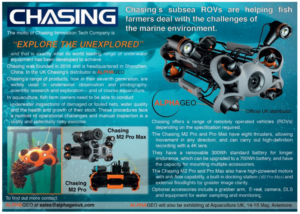Fit for an emperor
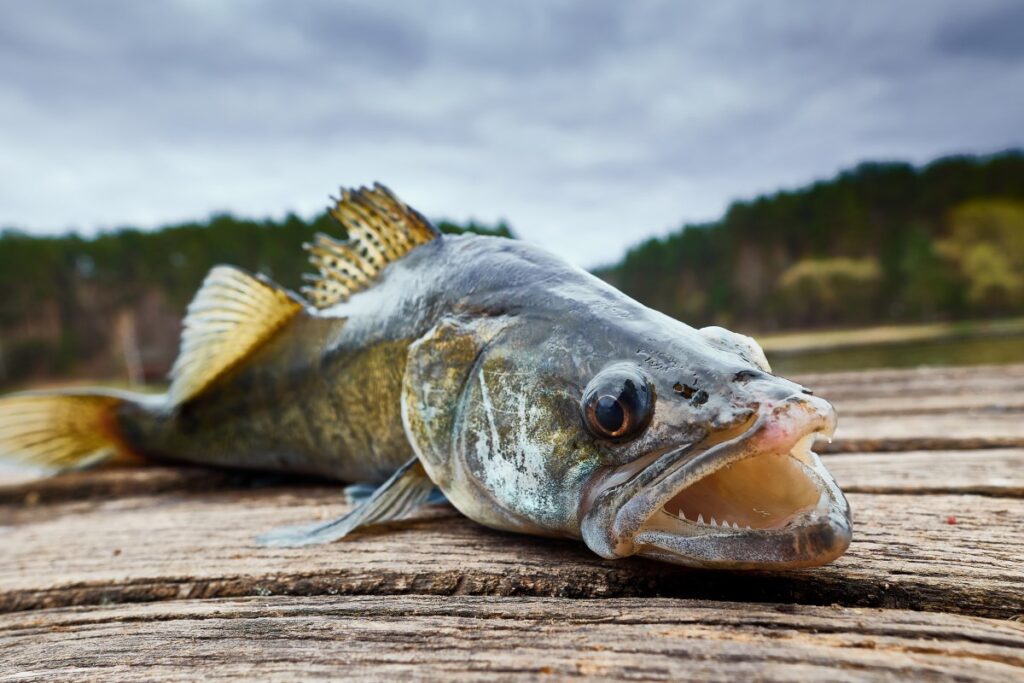
A RAS farm in Germany has been leading the way in raising pike-perch for the table at a commercial scale. Robert Outram reports
Mark Saalmann has some advice for any aquaculturist looking to start farming a new species.
As he explains: “Every fish is different. You can’t build a trout farm for a pike-perch.”
Saalmann is Farm Manager with Kaiserzander, Germany’s largest pike-perch producer and one of the pioneers in the industry.
Pike-perch (Sander lucioperca), also known as zander, is native to much of Europe. It favours large, turbid rivers, lakes and estuaries. In sport fishing, it is popular with anglers and makes good eating, but the pike-perch’s cannibalistic tendencies make it hard to farm in traditional pond aquaculture at a large scale, so up until now it has been a rare treat.

Mark Saalmann
From around 2000, various institutes started exploring the possibilities of raising pike-perch in recirculating aquaculture systems (RAS) and in 2013, two businessmen, Stefan Glammeier and René John, became interested in its commercial possibilities.
After a couple of years, however, it became clear that there was no useful RAS setup developed and available to buy for these kinds of species.
As Saalmann puts it: “In Germany there were only a few farms on the market and they were not really working.”
Saalmann had not farmed pike-perch before but he had experience in freshwater fish farming, including trout and sturgeon in RAS and then perch, before moving to a company building RAS.
Glammeier and John hired a team of aquaculture specialists and purchased a pilot facility that had been set up to farm pike-perch. It soon became clear, however, that the setup was not fit for purpose.
As Saalmann explains: “Pike-perch needs completely stable water quality; it has very high needs in terms of water quality. So we rebuilt the farm completely, with a new, state-of-the-art RAS system specifically for pike-perch.”
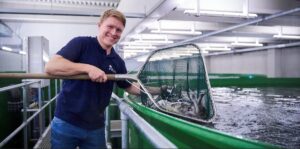
Pike perch
There were a number of factors to address, such as water quality, light, fish density, feed, type of filtration and optimum size for the farm.
The design was their own but to build it, Kaiserzander brought some external specialists for hydraulic and dimension of filter components.
It soon became clear that another key challenge would be sourcing sufficient fingerlings. Kaiserzander needed juveniles that were adapted to dry feed and be relaxed in an RAS. They also needed to be “clean” fish that were free of parasites and other pathogens.
Existing pike-perch hatcheries were small suppliers and they could not guarantee either the quantity or the quality required to produce four batches of 35,000 juveniles every year.
Saalmann says: “This was our main bottleneck for our business in that time.”
In the end, Kaiserzander bought fingerlings from four different suppliers as the basis for its own broodstock and raised them in its own hatchery facility at Niederlangen, built in 2020.
The grow-out facility at Porta Westfalica now has capacity for producing 100 tonnes annually and it could be scaled up to 250 tonnes.
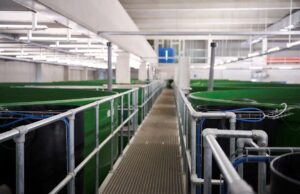
Kaiserzander hatchery
The location is also part of the inspiration for the company’s name. Porta Westfalica is the site of a massive monument commemorating Wilhelm I, the first emperor or kaiser of Germany. It has also been noted that the distinctive dorsal fin of the pike-perch looks like a crown.
To achieve year-round production there are four “climate rooms” encouraging the fish to spawn in every season, not just May and June, their natural mating period.
The fact that the fish are raised in a closed system reduces the risk of disease.
The RAS setup is designed to be energy-efficient, not using power it does not need. Heating is provided by biogas, electricity from solar and wind energy – with a wind turbine on-site – and there is a battery to retain the energy from solar panels to keep the system running during the night.
Saalmann stresses: “Our investors were particularly interested in pike-perch farming as a sustainable business.”
Addressing the cannibalism issue was clearly crucial. Saalmann explains: “You have to train them – they start as larvae eating live feed and then move on to the dry feed. They always need to be full of food, so never get them hungry.”
Initially there was no feed on the market specifically for pike-perch. The first useful feed was for turbot. Later, the formulation was changed a bit more for the needs of pike-perch.
Saalmann says: “We realise the minimum feed quantities to produce a pike-perch feed.”
Another factor is that the market is growing, with more producers setting up in countries including France, Austria, Switzerland, Hungary, the Czech Republic and Poland.
At present a large proportion of Kaiserzander’s juveniles are sold to other farmers, as well as a small number to stock sports fisheries, since the hatchery can currently produce more fingerlings than the grow-out facility requires.
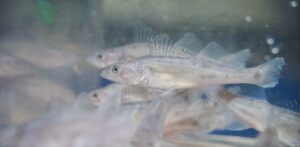
Kaiserzander young fish
Saalmann isn’t worried about the competition; in fact, he says, the arrival of more producers is a good thing. It is bringing more feed suppliers into the pike-perch market, making feed cheaper and creating more interest in the consumer marketplace for fresh and sustainable pike-perch.
This is Kaiserzander’s second year of commercial production in the market. Previously there was some overproduction, but this was mainly a marketing issue, Saalmann says, adding: “I think we can sell all our fish this year and we can double our production fairly quickly.”
There is space in the system to add more tanks and it has been designed to accommodate that.
Kaiserzander will hopefully pass the breakeven point and become profitable over the next few years.
Saalmann says: “If you have a very cheap fish, you can sell it immediately. If you have a sustainable, high-priced, good product, you need to do more marketing and people need to understand the story of your company. But if you have a good argument, you can sell it.
“It’s local, it’s produced in Germany and it’s sustainable.”
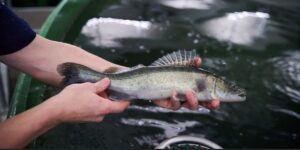
Kaiserzander fish
Pike-perch in the UK
Zander or pike-perch are not native to the UK and it is technically illegal to release them in British waters. They were introduced in England in Victorian times, however, and have since spread as an invasive species, even being recorded as far as Scotland. They are voracious predators and can be a problem for native fish stocks – especially in murky rivers and lakes, where their keen eyesight gives them an advantage. British anglers who hook a pike-perch are recommended to take it home and eat it.
Pike-perch farming in Europe
The UN Food and Agricultural Organization (FAO) has published an information sheet on pike-perch cultivation.
The FAO notes that the beginnings of pike-perch (Sander lucioperca) culture date to the nineteenth century and are linked to carp (Cyprinus carpio) culture in earthen ponds in Central and Eastern Europe. Pike-perch was produced in insignificant quantities as a so-called “additional” fish.
In the early twentieth century, production began of pike-perch stocking material (summer and autumn fry) in earthen ponds (natural spawning) for stocking open waters. It was produced in monoculture (summer fry) or in polyculture with carp (autumn fry). Pond pike-perch culture also began to develop in Western Europe (e.g. France) in the second half of the twentieth century. This type of pike-perch production has been and remains extensive in character, and this species has been and currently is viewed only as a supplementary fish.
At the beginning of the twenty-first century, the first aquaculture facilities producing pike-perch in recirculation aquaculture systems (RAS) were established in Western Europe and, by the close of the first decade, there were less than 10 of these facilities.
Methods for intensive pike-perch culture are in the initial stages of development but this species is considered to offer good prospects for European aquaculture.
Up until the recent rise of modern RAS producers (such as Kaiserzander), the main producing countries were the Czech Republic, Denmark, Hungary, Romania, Tunisia and Ukraine. Pike-perch are also grown in the Netherlands and Poland.
In 2009, annual aquaculture production of pike-perch exceeded 100 tonnes in only three countries – Denmark, Tunisia and Ukraine.
Total pike-perch production in aquaculture (653 tonnes) in 2009 was less than 5% of the level caught in open waters (14,739 tonnes).
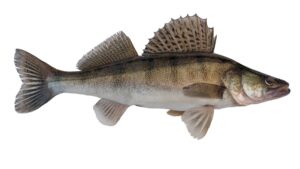
Pike perch
The FAO notes that several methods are used for reproduction:
• Uncontrolled natural reproduction – the fish are simply left to spawn in the ponds.
• Controlled natural reproduction – the fish are kept in small ponds specifically for spawning.
• Reproduction in lake cages – typically used in Finland.
• Artificial reproduction – fertilisation of eggs in a hatchery.
• Out-of-season reproduction – requiring control of light and temperature in an RAS system, as with Kaiserzander’s hatchery. Ongrowing in RAS systems is still a developing sector for this species. The FAO notes that fish of more than 1kg can be obtained after about 15 to 18 months of ongrowing in RAS.
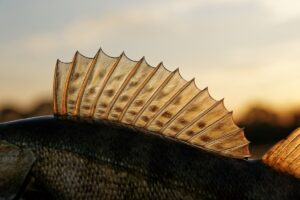
Pike perch or walleye
RAS grow-out feeds are high in protein (42% to 50%) and low in lipid (8% to 14%). The thermal optimum for pike-perch growth is about 27°C to 28°C, the FAO says, but fast growth rates are already noted at 23°C.
Slaughter yields, by weight, at various stages of processing are as follows: gutted fish (84% to 88%); headed gutted carcass (63% to 66%); fillet with skin (54% to 57%); and fillet without skin (48% to 51%).
Source: Cultured Aquatic Species Information Programme, Fisheries and Aquaculture Division, FAO

